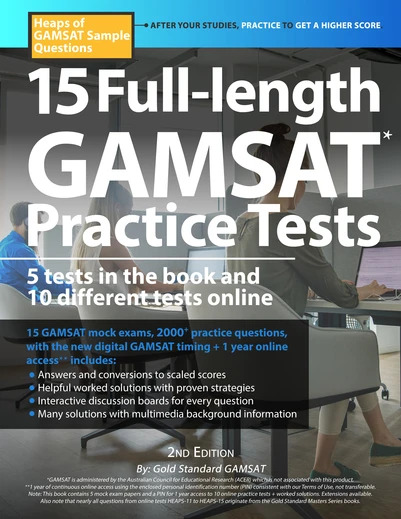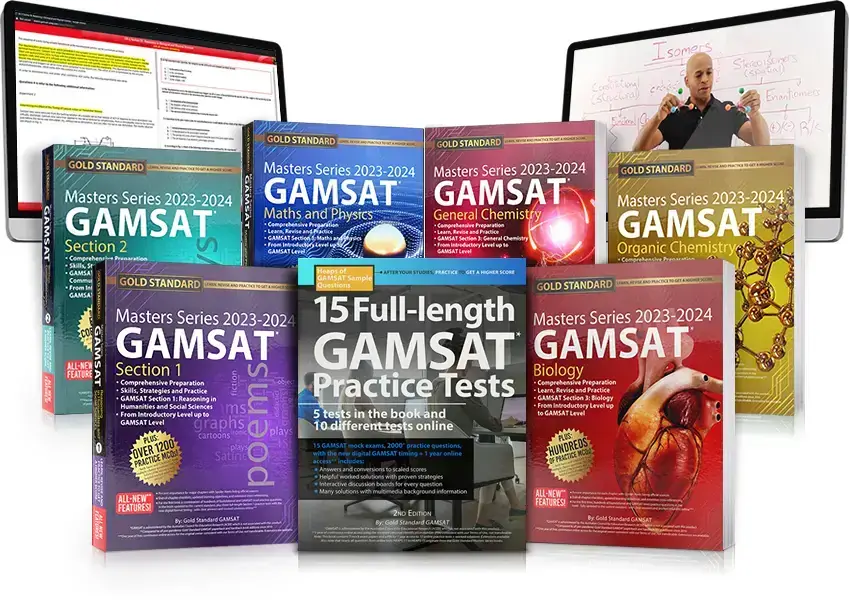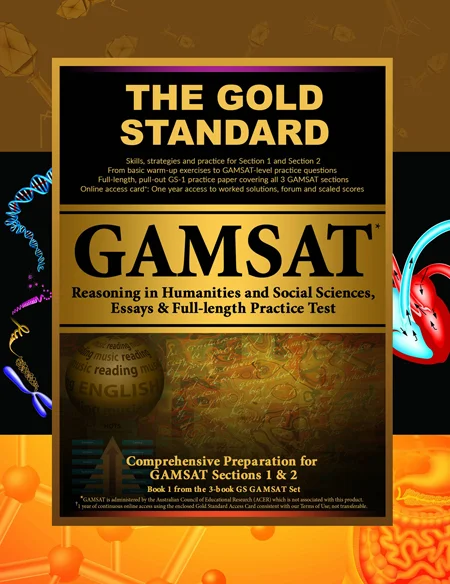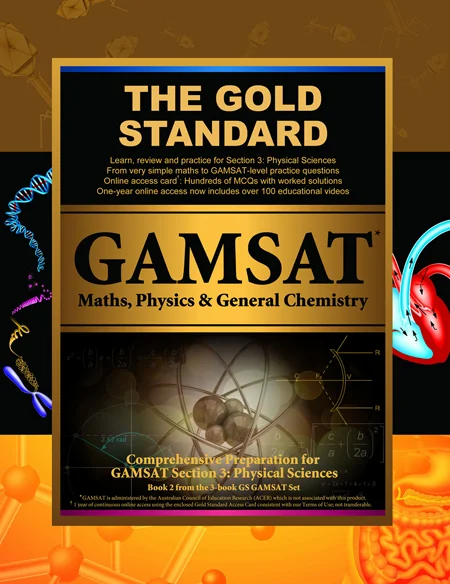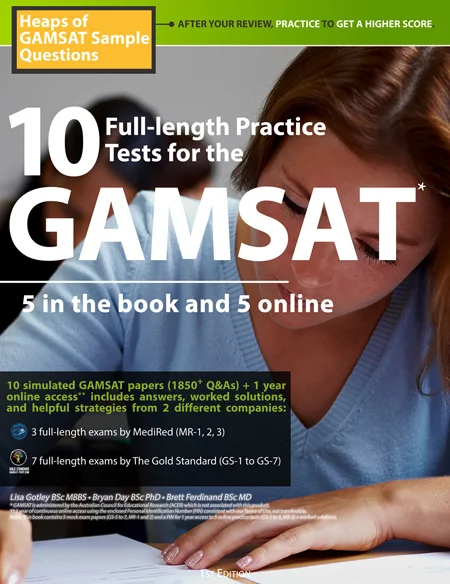| Distribution in Australia, NZ and Asia Woodslane Pty Ltd 10 Apollo Street Warriewood NSW 2102 Australia ABN: 76 003 677 549 Phone number to track product shipments: +612 8445 2300 GAMSAT Courses: +612 8005 0922 learn@gamsat-prep.com |
| Distribution in Europe Central Books 99 Wallis Road LONDON, E9 5LN United Kingdom Ship/track: +44 20 8525 8800 Alt phone: +44-845-458-9911 orders@centralbooks.com |
| Distribution in North America GAMSAT Prep/RuveneCo 334 Cornelia Street # 559 Plattsburgh, New York 12901 USA Courses/ship: 1(866) 333-3138 buy@gamsatbooks.com |
GAMSAT Physics
We have over 6000 practice problems with worked solutions, so we thought we should start sharing some! Here are 15 GAMSAT Physics sample questions from the Gold Standard. Don't worry, we will start off with the basics and then work up to GAMSAT-level reasoning. When you are done, you can find a lot of other Gold Standard free resources including the GAMSAT Question of the Day, Free GAMSAT Practice Test, webinars, on-campus seminars and a lot more! Good luck with the practice questions below!
Ideally, you would time yourself to complete these 15 questions. You have 20 minutes. Answers and worked solutions will follow. Oh, and of course, no calculators.
Questions:
1) Two forces have magnitudes of 11 newtons and 5 newtons. The magnitude of their sum could be equal to all of the following values EXCEPT one. Which one is the EXCEPTION?
A. 10 N
B. 7 N
C. 5 N
D. 16 N
2) If the sum of all the forces acting on a moving object is zero, the object will:
A. slow down and stop.
B. decelerate uniformly.
C. increase velocity only if there is no friction.
D. continue moving with constant velocity.
3) If the direction of a moving car changes and its speed remains constant, which quantity must remain the same?
A. Momentum
B. Displacement
C. Velocity
D. Kinetic energy
4) Two cylindrical wires are drawn from the same material, one having a radius twice that of the other but both wires being of the same length. What is the ratio of the resistances in the two wires?
A. 1:1
B. 2:1
C. 4:1
D. 8:1
5) An object weighs 60 newtons on Earth's surface. When the same object is moved to a point one Earth radius above Earth's surface, what would be its weight?
A. 120 N
B. 15 N
C. 30 N
D. 60 N
6) A spring scale reads 10 newtons as it pulls a 25 kilogram mass across a flat surface. What is the magnitude of the force exerted by the mass on the spring scale?
A. 250 N
B. 50 N
C. 25 N
D. 10 N
7) A 20 kg child is playing on a swing of negligible mass. It is attached to its pivot point with two 3 m ropes. The maximum speed of the child during a swing cycle is found to be 3 m/s. What is the maximum tension in each rope?
A. 200 N
B. 260 N
C. 60 N
D. 130 N
8) A raft is constructed from wood that has a density of 400 kg/m3. Ten identical sections of wood (width, 25 cm; depth, 10 cm; length, 4 m) are tied together side by side to build the raft. The density of water is 1000 kg/m3. How much of the unloaded raft, in depth, is underwater?
A. 2 cm
B. 4 cm
C. 6 cm
D. 10 cm
9) A copper rod which is 5 centimeters in diameter and infinitely long carries a current of 2 amps. The current is distributed uniformly throughout the rod. The magnetic field half way between the axis of the rod and its outside edge is:
A. zero.
B. pointing radially inward.
C. pointing radially outward.
D. encircling the axis of the rod.
10) A ball is thrown up in the air with a velocity of 10 m/s. Which of the following is true?
A. Time in air is 1 s; maximum height is 5 m.
B. Time in air is 1 s; maximum height is 10 m.
C. Time in air is 2 s; maximum height is 5 m.
D. Time in air is 2 s; maximum height is 10 m.
11) An electron moving at constant velocity enters the area between two charged plates, as shown in the diagram below. Which of the paths correctly indicates the electron's trajectory after leaving the area between the charged plates?

12) A person stands on a scale in an elevator. He notices that the scale reading is lower than his usual weight. Which of the following could possibly describe the motion of the elevator?
A. It is moving down and slowing down.
B. It is moving down at constant speed.
C. It is moving up and slowing down.
D. It is moving up with constant speed.
13) The cruising altitude of most planes is about 40,000 feet above sea level where there is less air above the plane pushing down, so the air pressure is lower (about 20 kPa outside compared to about 100 kPa atmospheric pressure at sea level). To keep everyone comfortable inside the plane, the cabin is pressurized to about 75 kPa. The passenger doors on a 747 are about 1 meter wide by 2 meters tall.

If a metric ton is 1000 kg, to pull the door open at 40,000 feet is equivalent to moving how many metric tons?
A. 5 x 10-2 tons
B. 0.8 tons
C. 2 tons
D. 11 tons
14) A box sits on an inclined plane without sliding. As the angle of the plane (measured from the horizontal) increases, the normal force:
A. decreases nonlinearly.
B. increases nonlinearly.
C. increases linearly.
D. does not change.
15) What is the voltage drop across R3 in the circuit diagram below?

A. 15 V
B. 30 V
C. 40 V
D. 100 V
Answer Key:
1. C
2. D
3. D
4. C
5. B
6. D
7. D
8. B
9. D
10. C
11. B
12. C
13. D
14. A
15. B
SOLUTIONS / EXPLANATIONS:
*Gold Standard GAMSAT textbook Reference
1) If you are adding these 2 vectors, let's consider the 2 extreme situations (i.e. the highest possible value and the lowest possible value): (1) they are pointing in exactly the same direction so the sum is 11 + 5 = 16 N; (2) they are pointing in exactly the opposite directions so the sum is 11 + (-5) = 6 N. Anything from 6 N to 16 N is possible but nothing above or below.
*PHY 1.1
2) Newton's 1st law states that an object in motion will stay in motion at constant velocity unless acted upon by an unbalanced force. For something to change direction or accelerate there must be an unbalanced force acting on it.
*PHY 4.2
3) If the direction changes, then all vectors change: momentum, displacement and velocity. Kinetic energy is a scalar and does not depend on direction. As long as the speed remains the same, the kinetic energy remains the same.
*PHY 1.1, 5.1, 5.2
4) Imagine that you needed to run down a hallway but you had 2 choices: (1) a very narrow hallway with a certain density of students there, just milling around OR (2) a wide hallway with the SAME density of students. Think for a moment. If you run down a wide hallway with the same density, you always have more options to choose from: left, right, sideways and so you can get through faster. It's the same with the electrons going through these 2 wires, same density but one with a greater radius.
Actually, a wire is like a tiny cylinder and if you cut a wire and look at its edge, the shape is a tiny circle. So it's not just a matter of the radius that is bigger, it's actually the area of a circle that is bigger. So we can summarize by saying: as the area increases, resistance decreases. Or, in "math-speak", resistance is inversely proportional to the cross-sectional area.
Now we have our first basic high school equation that must be memorized!
The resistance (R) is inversely proportional to the cross-sectional area (A), where
Acircle = π(radius)2
If radius1 = 2 x radius2, then A1 = (2A2)2 = 4A2 and R1 = 1/4 R2, giving us a ratio of R1:R2 --> 4:1.
*PHY 10.2 (B: PHY 3.3)
5) You would be expected to know: Newton's Law of Gravitation F = Gm1m2/r2 (you would never perform a complete calculation on the GAMSAT using values for each of the unknowns in the equation because there is just not enough time! However, you must know the relationship so that you can make assessments as to the relative changes of the variables in the equation).
When the object is moved 1 Earth radius away from the Earth then r is now 2r (on the surface of the earth the object is 1 Earth radius away from the center of the Earth, when the object is moved 1 radius away the distance is now r + r = 2r).
When you plug (2r)2 into the denominator of the equation it becomes 4r2. Thus when you double the distance, you quarter the force (same relationship with Coulomb's Law and point charges). So if we start with a force of 60 N, then we end with 15 N. Not much to calculate!
*PHY 2.4
6) This is a common exam question testing your understanding of Newton's 3rd Law: for every action, there is an equal and opposite reaction. When you push a couch, the couch is pushing back against your body with an equal force. The mass in the question exerts a 10 N force back on the spring because action/reaction forces are equal.
*PHY 2.3
7) The tension in the ropes is largest when the ropes are vertical because at that moment, the centripetal force is maximum and in the same direction as gravity. Clearly, the speed of the child is maximum at the point of lowest (gravitational) potential energy; therefore, the centripetal force is also maximum at that point.
Centripetal force = mv2/r = (20 x 3 x 3)/3 = 60 N
Weight = 200 N
Maximum force = 200 + 60 = 260 N
Maximum tension in each rope = 260/2 = 130 N
*PHY 3.3
8) First let's calculate the specific gravity (SG) of wood which is simply the density of wood divided by the density of water which is 400/1000 = 0.4.
SG is equal to the fraction of the height of a buoyant (= floating) object below the surface. So we know the fraction is 0.4 and now we need to apply that to the total "height" which is the depth of the wood 10 cm. So 0.4 x 10 = 4 cm.
*PHY 6.1.1, 6.1.2
9) The right-hand rule describes the direction of the magnetic field: as you "grab" the wire with your thumb in the direction of the flow of current, the tips of your fingers trace the direction of the magnetic field which encircles the wire. See PHY 9.2.3 of the Gold Standard GAMSAT book.
*PHY 9.2.2, 9.2.3
10) v = vo + gt
t = (v-vo)/g = 10/10 = 1 s
total time in air (to go up and back down) = 2t = 2 s
And, s = vot + (g/2)(t2)
= (10 x 1) - (10/2)(1)
= 5 m (max. height)
Yes, there are some very basic physics equations that you should know for the GAMSAT and we have listed them all here: www.gamsat-prep.com/section3-physics-formula-list/
*PHY 1.6, 2.6
11) While in the area between the plates, the negatively charged electron is attracted to the positive plate and so it would bend "upwards". But after leaving the plates, there is no more net force acting on the electron. Therefore, the electron would continue in motion in a straight line according to Newton's first law (inertia).
Oh, btw, the real GAMSAT: only 4 answer choices for all multiple choice questions. We just had to make this question 20% better but we promise not to do it again!! : )
*PHY 9.1.3, 4.2
12) You can draw a free-body diagram of the person:
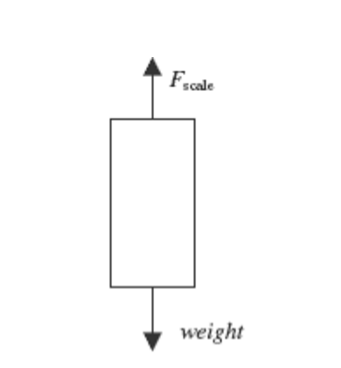
If upwards is positive, and we know that the sum of forces is equal to ma from Newton's 2nd Law, we get:
Fscale - weight = ma
The scale reading is less than his normal weight, so the acceleration is negative; i.e., down. Downward acceleration means either something speeds up while moving downward, or slows down while moving upward.
*PHY 2.2, 3.4
13) Key points: (1) pressure is defined as force per unit area (just apply some pressure to the table in front of you and you'll would have to say that you are applying a certain force over a particular area); (2) dimensional analysis: kilo means 1000 in the SI system and pascals or Pa, being force/area, has the equivalent units of N/m2.
The difference in pressure between inside and outside the cabin at 40,000 feet is: 75 – 20 = 55 kPa = 55 000 Pa or N/m2 of pressure pushing on the door.
Pressure: P = F/A
The area of the door is 2 x 1 = 2m2
So F = PA = (55 000)(2) = 110 000 N
Thus weight mg = 110 000 meaning m = 11 000 kg or 11 metric tons.
*PHY 6.1.2
14) Because no forces act perpendicular to the incline except for the normal force and the perpendicular component of weight, and there is no acceleration perpendicular to the incline, the normal force is equal to the perpendicular component of weight, which is mg cosθ. As the angle increases, the cosine of the angle decreases. This decrease is nonlinear because a graph of the normal force N vs. θ would show a curve, not a line.
*PHY 3.2, 3.2.1
15) The 10 A of current splits into two paths. The path through R2 takes 7 A, so the path through R3 takes 3 A (this is Kirchoff's First Law, the junctional theorem). Now use Ohm's law, where the voltage V is equal to the current I times the resistance R (Ohm's law is a frequent visitor in the real GAMSAT).
V = IR
V = (3 A) (10 Ω) = 30 V.
*PHY 10.1, 10.2, 10.3
Ideally, you would time yourself to complete these 15 questions. You have 20 minutes. Answers and worked solutions will follow. Oh, and of course, no calculators.
1) Two forces have magnitudes of 11 newtons and 5 newtons. The magnitude of their sum could be equal to all of the following values EXCEPT one. Which one is the EXCEPTION?
A. 10 N
B. 7 N
C. 5 N
D. 16 N
2) If the sum of all the forces acting on a moving object is zero, the object will:
A. slow down and stop.
B. decelerate uniformly.
C. increase velocity only if there is no friction.
D. continue moving with constant velocity.
3) If the direction of a moving car changes and its speed remains constant, which quantity must remain the same?
A. Momentum
B. Displacement
C. Velocity
D. Kinetic energy
4) Two cylindrical wires are drawn from the same material, one having a radius twice that of the other but both wires being of the same length. What is the ratio of the resistances in the two wires?
A. 1:1
B. 2:1
C. 4:1
D. 8:1
5) An object weighs 60 newtons on Earth's surface. When the same object is moved to a point one Earth radius above Earth's surface, what would be its weight?
A. 120 N
B. 15 N
C. 30 N
D. 60 N
6) A spring scale reads 10 newtons as it pulls a 25 kilogram mass across a flat surface. What is the magnitude of the force exerted by the mass on the spring scale?
A. 250 N
B. 50 N
C. 25 N
D. 10 N
7) A 20 kg child is playing on a swing of negligible mass. It is attached to its pivot point with two 3 m ropes. The maximum speed of the child during a swing cycle is found to be 3 m/s. What is the maximum tension in each rope?
A. 200 N
B. 260 N
C. 60 N
D. 130 N
8) A raft is constructed from wood that has a density of 400 kg/m3. Ten identical sections of wood (width, 25 cm; depth, 10 cm; length, 4 m) are tied together side by side to build the raft. The density of water is 1000 kg/m3. How much of the unloaded raft, in depth, is underwater?
A. 2 cm
B. 4 cm
C. 6 cm
D. 10 cm
9) A copper rod which is 5 centimeters in diameter and infinitely long carries a current of 2 amps. The current is distributed uniformly throughout the rod. The magnetic field half way between the axis of the rod and its outside edge is:
A. zero.
B. pointing radially inward.
C. pointing radially outward.
D. encircling the axis of the rod.
10) A ball is thrown up in the air with a velocity of 10 m/s. Which of the following is true?
A. Time in air is 1 s; maximum height is 5 m.
B. Time in air is 1 s; maximum height is 10 m.
C. Time in air is 2 s; maximum height is 5 m.
D. Time in air is 2 s; maximum height is 10 m.
11) An electron moving at constant velocity enters the area between two charged plates, as shown in the diagram below. Which of the paths correctly indicates the electron's trajectory after leaving the area between the charged plates?

12) A person stands on a scale in an elevator. He notices that the scale reading is lower than his usual weight. Which of the following could possibly describe the motion of the elevator?
A. It is moving down and slowing down.
B. It is moving down at constant speed.
C. It is moving up and slowing down.
D. It is moving up with constant speed.
13) The cruising altitude of most planes is about 40,000 feet above sea level where there is less air above the plane pushing down, so the air pressure is lower (about 20 kPa outside compared to about 100 kPa atmospheric pressure at sea level). To keep everyone comfortable inside the plane, the cabin is pressurized to about 75 kPa. The passenger doors on a 747 are about 1 meter wide by 2 meters tall.

If a metric ton is 1000 kg, to pull the door open at 40,000 feet is equivalent to moving how many metric tons?
A. 5 x 10-2 tons
B. 0.8 tons
C. 2 tons
D. 11 tons
14) A box sits on an inclined plane without sliding. As the angle of the plane (measured from the horizontal) increases, the normal force:
A. decreases nonlinearly.
B. increases nonlinearly.
C. increases linearly.
D. does not change.
15) What is the voltage drop across R3 in the circuit diagram below?

A. 15 V
B. 30 V
C. 40 V
D. 100 V
1. C
2. D
3. D
4. C
5. B
6. D
7. D
8. B
9. D
10. C
11. B
12. C
13. D
14. A
15. B
*Gold Standard GAMSAT textbook Reference
1) If you are adding these 2 vectors, let's consider the 2 extreme situations (i.e. the highest possible value and the lowest possible value): (1) they are pointing in exactly the same direction so the sum is 11 + 5 = 16 N; (2) they are pointing in exactly the opposite directions so the sum is 11 + (-5) = 6 N. Anything from 6 N to 16 N is possible but nothing above or below.
*PHY 1.1
2) Newton's 1st law states that an object in motion will stay in motion at constant velocity unless acted upon by an unbalanced force. For something to change direction or accelerate there must be an unbalanced force acting on it.
*PHY 4.2
3) If the direction changes, then all vectors change: momentum, displacement and velocity. Kinetic energy is a scalar and does not depend on direction. As long as the speed remains the same, the kinetic energy remains the same.
*PHY 1.1, 5.1, 5.2
4) Imagine that you needed to run down a hallway but you had 2 choices: (1) a very narrow hallway with a certain density of students there, just milling around OR (2) a wide hallway with the SAME density of students. Think for a moment. If you run down a wide hallway with the same density, you always have more options to choose from: left, right, sideways and so you can get through faster. It's the same with the electrons going through these 2 wires, same density but one with a greater radius.
Actually, a wire is like a tiny cylinder and if you cut a wire and look at its edge, the shape is a tiny circle. So it's not just a matter of the radius that is bigger, it's actually the area of a circle that is bigger. So we can summarize by saying: as the area increases, resistance decreases. Or, in "math-speak", resistance is inversely proportional to the cross-sectional area.
Now we have our first basic high school equation that must be memorized!
The resistance (R) is inversely proportional to the cross-sectional area (A), where
Acircle = π(radius)2
If radius1 = 2 x radius2, then A1 = (2A2)2 = 4A2 and R1 = 1/4 R2, giving us a ratio of R1:R2 --> 4:1.
*PHY 10.2 (B: PHY 3.3)
5) You would be expected to know: Newton's Law of Gravitation F = Gm1m2/r2 (you would never perform a complete calculation on the GAMSAT using values for each of the unknowns in the equation because there is just not enough time! However, you must know the relationship so that you can make assessments as to the relative changes of the variables in the equation).
When the object is moved 1 Earth radius away from the Earth then r is now 2r (on the surface of the earth the object is 1 Earth radius away from the center of the Earth, when the object is moved 1 radius away the distance is now r + r = 2r).
When you plug (2r)2 into the denominator of the equation it becomes 4r2. Thus when you double the distance, you quarter the force (same relationship with Coulomb's Law and point charges). So if we start with a force of 60 N, then we end with 15 N. Not much to calculate!
*PHY 2.4
6) This is a common exam question testing your understanding of Newton's 3rd Law: for every action, there is an equal and opposite reaction. When you push a couch, the couch is pushing back against your body with an equal force. The mass in the question exerts a 10 N force back on the spring because action/reaction forces are equal.
*PHY 2.3
7) The tension in the ropes is largest when the ropes are vertical because at that moment, the centripetal force is maximum and in the same direction as gravity. Clearly, the speed of the child is maximum at the point of lowest (gravitational) potential energy; therefore, the centripetal force is also maximum at that point.
Centripetal force = mv2/r = (20 x 3 x 3)/3 = 60 N
Weight = 200 N
Maximum force = 200 + 60 = 260 N
Maximum tension in each rope = 260/2 = 130 N
*PHY 3.3
8) First let's calculate the specific gravity (SG) of wood which is simply the density of wood divided by the density of water which is 400/1000 = 0.4.
SG is equal to the fraction of the height of a buoyant (= floating) object below the surface. So we know the fraction is 0.4 and now we need to apply that to the total "height" which is the depth of the wood 10 cm. So 0.4 x 10 = 4 cm.
*PHY 6.1.1, 6.1.2
9) The right-hand rule describes the direction of the magnetic field: as you "grab" the wire with your thumb in the direction of the flow of current, the tips of your fingers trace the direction of the magnetic field which encircles the wire. See PHY 9.2.3 of the Gold Standard GAMSAT book.
*PHY 9.2.2, 9.2.3
10) v = vo + gt
t = (v-vo)/g = 10/10 = 1 s
total time in air (to go up and back down) = 2t = 2 s
And, s = vot + (g/2)(t2)
= (10 x 1) - (10/2)(1)
= 5 m (max. height)
Yes, there are some very basic physics equations that you should know for the GAMSAT and we have listed them all here: www.gamsat-prep.com/section3-physics-formula-list/
*PHY 1.6, 2.6
11) While in the area between the plates, the negatively charged electron is attracted to the positive plate and so it would bend "upwards". But after leaving the plates, there is no more net force acting on the electron. Therefore, the electron would continue in motion in a straight line according to Newton's first law (inertia).
Oh, btw, the real GAMSAT: only 4 answer choices for all multiple choice questions. We just had to make this question 20% better but we promise not to do it again!! : )
*PHY 9.1.3, 4.2
12) You can draw a free-body diagram of the person:

If upwards is positive, and we know that the sum of forces is equal to ma from Newton's 2nd Law, we get:
Fscale - weight = ma
The scale reading is less than his normal weight, so the acceleration is negative; i.e., down. Downward acceleration means either something speeds up while moving downward, or slows down while moving upward.
*PHY 2.2, 3.4
13) Key points: (1) pressure is defined as force per unit area (just apply some pressure to the table in front of you and you'll would have to say that you are applying a certain force over a particular area); (2) dimensional analysis: kilo means 1000 in the SI system and pascals or Pa, being force/area, has the equivalent units of N/m2.
The difference in pressure between inside and outside the cabin at 40,000 feet is: 75 – 20 = 55 kPa = 55 000 Pa or N/m2 of pressure pushing on the door.
Pressure: P = F/A
The area of the door is 2 x 1 = 2m2
So F = PA = (55 000)(2) = 110 000 N
Thus weight mg = 110 000 meaning m = 11 000 kg or 11 metric tons.
*PHY 6.1.2
14) Because no forces act perpendicular to the incline except for the normal force and the perpendicular component of weight, and there is no acceleration perpendicular to the incline, the normal force is equal to the perpendicular component of weight, which is mg cosθ. As the angle increases, the cosine of the angle decreases. This decrease is nonlinear because a graph of the normal force N vs. θ would show a curve, not a line.
*PHY 3.2, 3.2.1
15) The 10 A of current splits into two paths. The path through R2 takes 7 A, so the path through R3 takes 3 A (this is Kirchoff's First Law, the junctional theorem). Now use Ohm's law, where the voltage V is equal to the current I times the resistance R (Ohm's law is a frequent visitor in the real GAMSAT).
V = IR
V = (3 A) (10 Ω) = 30 V.
*PHY 10.1, 10.2, 10.3
